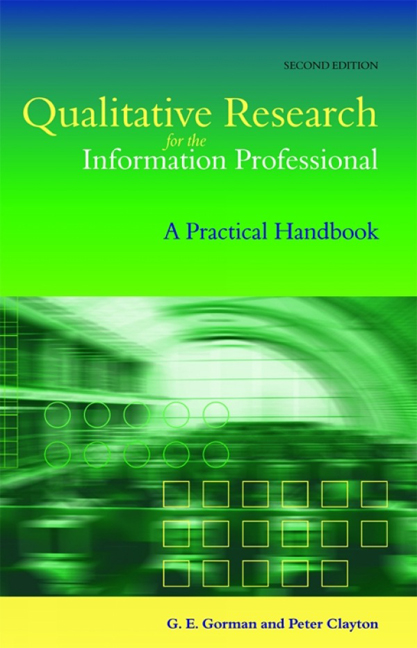Book contents
- Frontmatter
- Contents
- Tables, figures and research scenarios
- About the authors
- Preface to the second edition
- 1 The nature of qualitative research
- 2 Evaluating qualitative research
- 3 Qualitative research design in information organizations
- 4 Case studies in information organizations
- 5 Laying the foundations for fieldwork
- 6 Beginning fieldwork
- 7 Observation
- 8 Interviewing
- 9 Group discussion techniques
- 10 Historical investigation
- 11 Recording fieldwork data
- 12 Analysing qualitative data from information organizations
- 13 Writing qualitative research reports
- 14 Human resources in knowledge management: a case study
- Select bibliography
- Index
7 - Observation
Published online by Cambridge University Press: 08 June 2018
- Frontmatter
- Contents
- Tables, figures and research scenarios
- About the authors
- Preface to the second edition
- 1 The nature of qualitative research
- 2 Evaluating qualitative research
- 3 Qualitative research design in information organizations
- 4 Case studies in information organizations
- 5 Laying the foundations for fieldwork
- 6 Beginning fieldwork
- 7 Observation
- 8 Interviewing
- 9 Group discussion techniques
- 10 Historical investigation
- 11 Recording fieldwork data
- 12 Analysing qualitative data from information organizations
- 13 Writing qualitative research reports
- 14 Human resources in knowledge management: a case study
- Select bibliography
- Index
Summary
FOCUS QUESTIONS
• What are the main characteristics of unstructured observation as a qualitative research method?
• What are the various observation ‘positions’ on the participation continuum?
• What factors should be considered when selecting an appropriate observation position?
• How does one begin observation?
• How does one go about the actual observation process, and what does one observe?
Stage 3: focused activity
Once you have completed all the preliminary preparation (Stage 1) and broad exploration (Stage 2) for a qualitative study, it is time to begin the fieldwork. In our schema this is Stage 3: focused activity. In this chapter, after noting this stage and its several steps, we turn to the first data-collecting method, observation. Chapters 8, 9 and 10 then deal with the other data collection methods to be discussed, interviewing, group processes and historical study, before we move on to the final steps in this stage of the research project.
In the pyramid model (see Chapter 3, Figure 3.3, p. 38) the focused activity stage of fieldwork represents the pinnacle in which you finally collect data, amend the research plan if required, narrow your data-collecting activities, analyse data collected during fieldwork and report findings. The first three of these activities are discussed in this and the following three chapters. In the recursive model (see Chapter 3, Figure 3.2, p. 37) data collection is the third last in the series of activity ‘boxes’.
Two types of observation
This discussion builds on the introduction to observation in Chapter 3 (pages 40–41), which might be worth re-reading before continuing with the present chapter. Two broad types of observation are described in the general research methods literature: structured and unstructured observation. Structured observation samples a predetermined event or activity, using a prearranged instrument or form into whose categories the observer records whether specific activities take place, when and how often. This might be numbers of enquirers who approach an information counter. A well designed data collection form will also make provision for some unanticipated activity to be recorded. This is essentially a quantitative research method, and so not considered further in this volume.
- Type
- Chapter
- Information
- Qualitative Research for the Information ProfessionalA practical handbook, pp. 103 - 124Publisher: FacetPrint publication year: 2004

